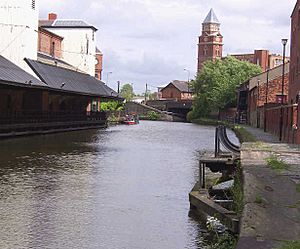Wigan Pier facts for kids
Wigan Pier is a famous area in Wigan, Greater Manchester, England. It's located near the Leeds and Liverpool Canal, a waterway that was very important for trade long ago. The name "Wigan Pier" often makes people smile because it sounds like a pier you'd find at the seaside. But Wigan is actually far from the coast and used to be a busy industrial town. So, it's a bit of a funny, ironic name!
Contents
The Story of Wigan Pier
What Was the Original Pier?
The first "pier" in Wigan wasn't a fun place for walks like a seaside pier. Instead, it was a simple wooden structure called a staithe. This was a loading dock where coal from nearby mines was tipped directly into barges on the canal. These barges would then carry the coal away. The original wooden pier was taken down in 1929. Its metal parts, including a special tipping machine, were sold for scrap.
How Did the Joke Begin?
The funny idea of Wigan having a "pier" became popular around 1891. A story goes that a train heading to Southport got stuck near Wigan. One passenger wondered where they were, and the answer became the start of the famous joke. At that time, a very long wooden bridge, or gantry, carried a railway line over the River Douglas, the canal, and the main railway. This gantry was a huge structure!
The famous comedian George Formby, Sr. helped make the joke even more popular in the early 1900s. He would perform in music halls in Wigan and even joked that he saw the "tide was in" at the pier, referring to how the low-lying area often flooded. By the time Formby passed away in 1921, and as the coal mines closed, the big gantry was gone. So, people started to think of the coal-tipping dock at the canal as the "Wigan Pier" from the joke.
Wigan Pier in Books and Songs
In 1937, Wigan became even more famous because of a book by George Orwell called The Road to Wigan Pier. This book described the tough living conditions of working-class people in England. Orwell himself was a bit disappointed because when he visited, the actual "pier" had already been taken down! He said he liked the people of Wigan, but not the scenery.
Some people in Wigan have used this link to Orwell to attract tourists. They feel that even though Orwell wrote about the difficult times, his book made Wigan well-known. Others don't like this connection, feeling it suggests Wigan hasn't improved much since then.
Orwell's book described the area around the canal as a "lunar landscape" with huge piles of waste from the mines, called slag-heaps. He wrote about factory chimneys puffing out smoke and paths made of ash and frozen mud. He also mentioned "flashes," which were pools of dirty water that collected in hollows where the ground had sunk from old mining. It sounded like a very cold and bleak place with no plants.
Wigan Pier Today
Today, Wigan Pier looks very different from Orwell's description. The old slag-heaps have been removed or covered with trees and plants. Many factories are now closed or have been turned into homes. The canal is no longer used for carrying coal but is a peaceful place for boat trips and fishing. It's a much greener and more pleasant area now.
Buildings at Wigan Pier
The Replica Coal Tippler
The original "pier" was where coal wagons would tip their contents into barges. While the first wooden pier was removed in 1929, a replica of the coal tippler has been built. This new structure, with its curved rails, helps people imagine how coal was loaded onto boats. It's a reminder of Wigan's industrial past.
Historic Warehouses
The old Wigan Terminus Warehouses were built in the 1700s. They were fixed up in the 1980s. These buildings were designed so that boats could actually moor inside them, allowing goods to be unloaded directly into the warehouse.
One of these warehouses was once a museum called "The Way We Were." It showed what Victorian life was like, with displays of a Victorian schoolroom and even a pub that was moved and rebuilt inside! This museum helped people remember the past, which wasn't always easy. The museum closed its doors in December 2007.
Gibson's Warehouse is another old building, originally from 1777. It was rebuilt in 1984 and is now known as The Orwell at Wigan Pier. It sits right by the canal.
Other Notable Buildings
Number 1 Wigan Pier received an award for its excellent refurbishment in the early 1980s.
Trencherfield Mill is a former cotton mill located near Wigan Pier. In 2009, it was turned into fancy apartments. What's special is that it still has a huge working steam engine inside, which was kept as part of the new development.
There are also several bridges over the canal. Bridge #51, called Pottery Changeline, is a "roving bridge." This type of bridge allows the towpath to switch from one side of the canal to the other. This was helpful for horses pulling barges, as they could cross without having to unhook their ropes. Bridge #50, Seven Stars Bridge, is named after a nearby pub that is no longer there.
Elizabeth House, located at The Pier, Wigan, is home to Keep Britain Tidy. This is an environmental charity that works to keep places clean.
Wigan Pier Nightspot was a very popular night club on the southern bank of the canal. It was a big attraction from the late 1980s until it closed in December 2011.
The Future of Wigan Pier
Exciting plans have been approved to improve the famous Wigan Pier area. These plans include building new homes, creating a special food hall for local artisan products, and setting up spaces for events. This will help bring new life and activities to the historic area.


